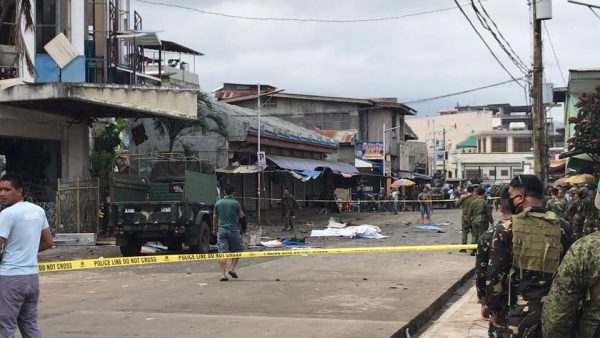While the plebiscite was a welcome development, popular support for political autonomy in Mindanao may not be enough to counter those seeking to derail the BARMM.
Twenty individuals were killed and many more wounded after two explosions struck the Cathedral of Our Lady of Mount Carmel during an early morning mass in downtown Jolo. The group responsible for the attack, the Abu Sayyaf Group (ASG), has long considered the cathedral a symbolic target. At least 10 attacks against the cathedral have been recorded since 2000 when the ASG became notorious for kidnapping and extortion.
The bombings are a reminder of the persistence of communal tensions in Jolo. In 1974, Jolo was destroyed after a pitched battle between the Philippine military and secessionist rebels. The image of an eclectic and commerce-driven Jolo was erased by conflict and this became a driver of Filipino Muslim secessionism. Jolo was reconstructed, but the razing of Jolo continues to evoke anti-government sentiments and communal tensions.
Jolo’s insecure frontier image led to the entrenchment of local political elites, which stunted the growth of democratic institutions and the rule of law. Prior to the BOL plebiscite, some local elected officials in Sulu voiced their opposition to the measure. The Bangsamoro government could potentially upend the informal institutions and patron-client relations that local political clans rely upon to preserve their influence.
The ‘no’ vote won in Sulu, demonstrating the power of local political elites to harness so-called ‘command votes’. But Sulu will still be part of the BARMM since the territory of the Autonomous Region in Muslim Mindanao (ARMM) as a whole, which will be replaced by the BARMM, voted to ratify the BOL.
The Jolo bombings also demonstrate the problem of weapons proliferation that any future Bangsamoro government will have to confront. Post-blast investigations reveal that the explosives used were typical of the types of improvised explosive devices used in the island provinces of Western Mindanao.
It is hoped that promised improvements in quality-of-life and governance from the Bangsamoro government will reduce the demand for illicit weapons. But the control of dual-use substances with legitimate industrial applications, such as ammonium nitrate-fuel oil, will be difficult to regulate.
The more pressing issue is on the supply side. Though the Moro Islamic Liberation Front (MILF) agreed to the disarmament and demobilisation of its fighters in a 2014 peace deal with Manila, some MILF commanders have expressed reservations about turning in their weapons. Exemption from disarmament is rationalised as a form of self-defence against the private militias that previously fought against the MILF and are still maintained by politicians.
It remains to be seen whether the Ajang-Ajang faction of the ASG, reportedly composed of relatives and kin of killed ASG leaders, was operating independently as the perpetrator of the bombings. One line of enquiry being pursued is the possibility that the attack is reprisal for the killing of ASG sub-leader Surakah Ingog in August 2018. At present, the Philippine government is sticking to the narrative of Filipino ASG members acting as the pathfinders for the alleged Indonesian suicide bombers that struck the cathedral.
The generational nature of violent extremism is a critical and often overlooked factor driving the emergence of splinter groups. The MILF that signed the 2014 peace deal paving the way for the BOL was a splinter group from the Moro National Liberation Front. There are also fears that orphans of members of Maute Group, a splinter from the MILF, killed in the 2017 Marawi siege will grow up resenting the government and be susceptible to violent extremist recruitment.
Beyond caring for vulnerable individuals, the Bangsamoro government will have to contend with the reality of multiple threat groups. The ASG, both its pro-Islamic State (IS) and its more criminally-oriented factions, are outside the scope of the formal Mindanao peace process, as are other lesser-known violent extremist groups such as Ansar Khilafah Philippines. These groups, unlike the MILF, have no intent to participate in autonomy or governance under the Philippine Republic.
The passing of the BOL plebiscite and the establishment of the BARMM are just the initial steps towards establishing lasting peace in Mindanao. The new regional government already faces the challenge of rebuilding from the ruins of Marawi. In the aftermath of the Jolo bombings, Manila is reminded once again of the structural issues that drive violent extremism domestically. The demise of IS’ physical caliphate or the discrediting of its ideology will not resolve the fundamental issues that Mindanao faces.
Communal tensions and the proliferation of weapons and bad actors will have to be resolved holistically by the future Bangsamoro and the Philippines’ national leadership.
Joseph Franco is a Research Fellow with the Centre of Excellence for National Security, S Rajaratnam School of International Studies (RSIS), Nanyang Technological University, Singapore.

